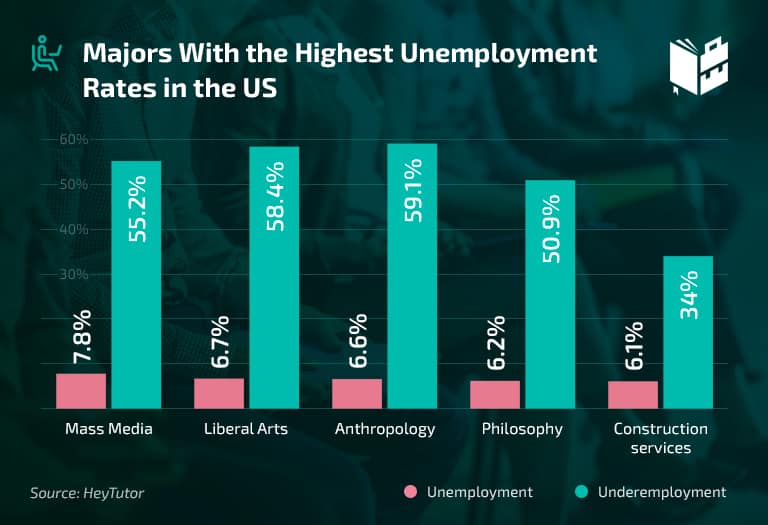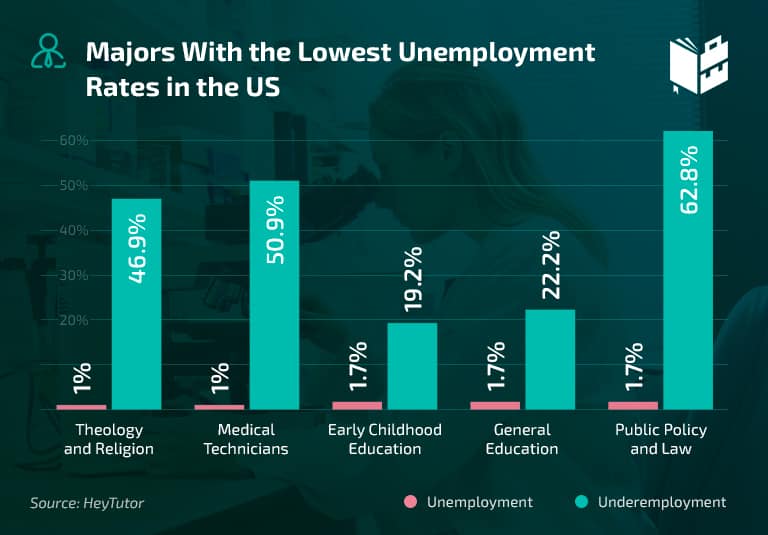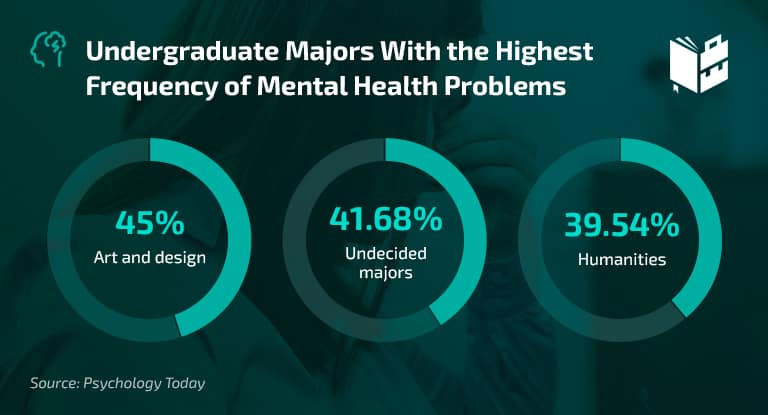As of the end of 2021, college major statistics show that over four million college students will graduate in the US alone. Deciding what to major in comes with a lot of consideration and can have an impact on future job opportunities and overall happiness.
While trends show that earlier generations were more likely to pursue degrees they were passionate about, today’s college students tend to choose majors that will land them better jobs after graduation. With a changing world and more people than ever receiving college degrees, check out these major stats to help you decide what’s the best choice for you.
Essential College Major Statistics (Editor’s Choice)
- 730,394 or 18.3% of college graduates earned degrees in STEM (science, technology, engineering, and mathematics), making it the most popular college major field.
- Asian/Pacific Islander students have the highest graduation rate of 69.3%.
- Engineering majors have the highest starting salaries with up to $69,961 per year.
- Millennials are most likely to change a major for a better job or more job opportunities.
- 41.6% of all students are dealing with some form of anxiety.
- Art and design majors report the highest rates of depression among college students, with 45%.
General College Majors Statistics
The job market, starting salaries, and your overall interest in the field are just a few considerations when choosing a college major. In recent years, however, certain majors have garnered more attention for job availability, while others remain steadily in high demand. For the first time, STEM outranked business degrees for enrollment, for example, and public health may be the new graduate program of choice.
1. STEM takes the lead for the most popular college majors by percentage, accounting for 18.3% of all degrees earned in the US.
(EducationData)
2020 seemed to be a great year for STEM programs, with 730,394 US graduates, outnumbering business graduates for the first time by 1.6%. Healthcare follows closely behind BA graduates, with 15.8% of all college students in the US.
2. Mass media majors struggle the most to gain meaningful employment after graduation, with 55.2% reporting underemployment.
(HeyTutor)
The unemployment rate by college major shows what fields are currently in demand. In the current job market, mass media majors have the highest rates of unemployment compared to other degree holders, with 7.8% reporting having no job and 55.2% reporting being underemployed.
Liberal arts majors follow closely behind, with an unemployment rate of 6.7% and an underemployment rate of 58.4%. Anthropology majors don’t fare so well either, with a 6.6% unemployment rate and 59.1% reporting underemployment.

3. With a 1% unemployment rate, medical technicians and theology and religion majors have the best career outcomes.
(HeyTutor)
Recent college major statistics show that medical tech degrees and theology majors are most likely to find work in their field. Other programs with high employment rates are early childhood education, education, public policy, and law.
Notably, while these fields share an unemployment rate of just 1.7%, underemployment reports greatly differ. For example, theology and religion majors have an underemployment rate of 46.9%, while the percentage for medical technicians is 50.9%. Early childhood and general education, on the other hand, have very low underemployment rates, with 19.2% and 22.2%.

4. 25% of college graduates choose a double major.
(web.archive.org)
When it comes to what percentage of people double major in college, studies show that one-quarter choose this route. In some schools, 30% to 40% of undergraduates complete the requirements needed for two majors.
Furthermore, studies show that 9% of men and 8% of women double major. Similarly, 9% of White and Hispanic students, 8% of Asian and Pacific Islanders, and 6% of African-American students take a double major.
5. College major graduation rates by race or ethnicity show that Asian/Pacific Islander students have the highest graduation rate of 69.3%.
(EducationData)
Asain/Pacific Islanders have the highest graduation rate in the US, and White or Caucasian students are right behind them, with a graduation rate of 62.2%. In third place are biracial students, with a graduation rate of 50.4%.
Hispanic or Latino students come in fourth, with a graduation rate of 41.5%, while Black and African American students are a close fifth, with a graduation rate of 40.5%. American Indian/Alaska Native students have the lowest rate of 39.3%.
6. According to national college major statistics, engineering majors had the highest starting salaries in 2020—$69,961.
(FinanceOnline)
Compared with the average salary of a regular college graduate, engineering majors have the highest starting salaries of all degree holders. Computer science majors also have higher starting salaries, with $67,411 annually. Math and science majors earn $62,488, business majors earn $57,939, and social sciences usually start around $57,425 per year.
7. 30.68% of Millennials would change their major to have better job opportunities compared to just 18.6% of Baby Boomers.
(Best Colleges)
Notably, 82% of graduates think their degree was an excellent financial investment, while 61% said they would choose a different major if they could go back in time.
College Major Statistics and Mental Health
College students are at risk of poor mental health outcomes. While there aren’t many statistics that examine mental health by major, some trends have been reported. Mainly, almost half of all college students suffer from anxiety and over one-third report depression. Mental health is the leading reason why youth drop out of college altogether.
8. According to college enrollment statistics by major, 45% of art and design majors struggle with depression.
(Psychology Today)
Even though little research has been done on the mental health of college students by major, one study found that art and design students are most likely to report mental health problems. Humanities students don’t fall far behind, with 39.5%, and undecided majors also show a high incidence of mental health issues, with 41.6%.

9. According to college majors statistics, 41.6% of all university students report dealing with anxiety.
(AUCCCD, csc.edu)
Based on a recent survey, 41.6% of all students have some form of anxiety, and 36.4% struggle with depression. 35.8% of students reported having relationship problems, and 24.5% of all students with anxiety or depression are already taking prescribed medications. Notably, for 64% of young adults, mental health is the reason cited for dropping out of college.
10. According to a recent study, 10.3% of college students have considered suicide in the past 12 months.
(Governors State University) (NCBI)
There aren’t any available suicide rates by college major, but there are different mental health outcomes for those who have a college degree and those who don’t. Notably, high school students are twice as likely to commit suicide than college students.
That’s not to say that suicide isn’t a concern on campuses across the United States. Suicide is the second leading cause of death among college students. Moreover, the COVID-19 pandemic is linked to the increasing number of suicide attempts.
Conclusion
With more students than ever enrolling in college, the factors that go into deciding on the major are changing. Even though business management has been the leading major in the last decade, studies on the number of college graduates by major show that STEM is emerging as the number one field among college enrollees.
While Baby Boomers might have been more likely to go to school to pursue a passion, today’s students are interested in practicality. As such, degrees that offer better job opportunities and starting salaries to new graduates are more popular than those that don’t.
Frequently Asked Questions (FAQ)
1. What is the most common major in college?
The most common major in college graduates is in STEM (science, technology, engineering, and mathematics) fields, with 730,394 or 18.3% of all college graduates earning a degree.
STEM recently replaced business, which now accounts for 699,505 graduates or 16.7% of all degrees earned. Surprisingly, the least popular undergraduate degree in the United States is computer sciences.
2. What is the most useless major in college?
Believe it or not, the most useless college degree is advertising. This might seem counterintuitive, but with the rise of social media, websites, and online ads, the traditional advertising methods are no longer producing the same results as before.
Other majors notorious for their lack of practicality in the job market are drama and performing arts, composition and rhetoric, fine arts, and music degrees.
3. Can you have a good life without college?
A college degree doesn’t automatically lead to a good life, although it can open you to new experiences, networks, and job opportunities that may not be accessible out of college. That being said, while college used to promise a higher-paying job, studies show that this trend is changing as more students enroll and flood the market.
Post-secondary education has become extremely expensive in the United States, and a rising student debt crisis questions the necessity of going to college. Other avenues for success can be skilled trades, technician programs, and other non-university training options.
4. What is the fastest-growing college major?
With a growth of over 160% in the past 13 years, nursing is among the fastest-growing college programs in the US. Other health and medical majors that are also growing by the minute are medical science, health science, nutrition science, and physician’s assistant. Notably, STEM has recently outranked business as the most popular major. College major statistics show that practical programs with high salaries and job openings for new graduates continue to grow, while passion-driven majors are pushed to the side.
Sources: AUCCCD, BestColleges, Columbia, Csc.edu, EducationData, FinanceOnline, Governors State University, HeyTutor, KHN, NCBI, USA Today, Web.archive.org